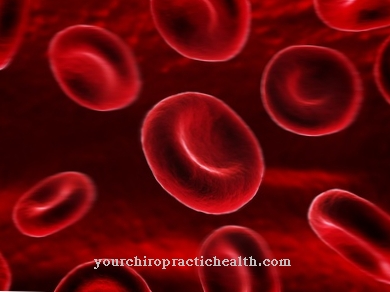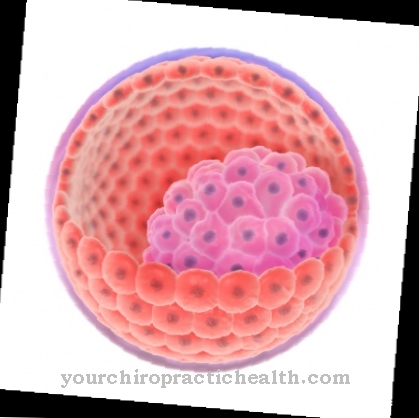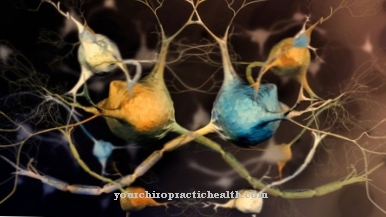The appositional ossification is the growth in thickness of the bones. Appositional growth takes place at the circumference and has its origin in the osteogenic stratum of the periosteum. If a bone grows aimlessly in width but no longer in length, movement restrictions arise.
What is appositional ossification?

The medical term ossification or osteogenesis names bone formation. Bone growth takes place either in length or in width. The growth in breadth is also referred to as thickness growth or appositional ossification. There is no permanent increase in length. The growth in thickness, on the other hand, is a permanent body process.
During appositional ossification, new layers of tissue attach to the bones from the outside. This makes the growth process a process of perichondral ossification. This is understood to mean indirect bone formation from the outside, which takes place via the intermediate step of the cartilage.
Appositional ossification affects both flat and short bones, as well as long tubular bones, and is an important part of bone remodeling. Through growth in thickness, bones adapt to certain loads or specific demands, for example.
Osteoblasts, osteoclasts and osteocytes are involved in the type of ossification. The basic substance for all bone formation processes is the embryonic connective tissue mesenchyme.
Function & task
In appositional ossification, new bone tissue is attached to existing bone tissue from the outside. Thickness growth always takes place on the bone cuff of the bone shaft and starts from the stratum osteogenicum. Towards the middle of the diaphysis, the new bone material attaches to the existing bone from outside. Periosteal cells form this new material during differentiation.
The periosteum is a thin layer of tissue on the outer surface of all bones. The inner layer consists of osteoblastic stem cells for bone regeneration. In the outer layer there is low-cell connective tissue full of collagen fibers.
The osteoblasts carry out the appositional growth. As embryonic mesenchymal cells, these cells are able to synthesize a collagenous bone matrix and produce osteoid for this purpose. As the bone formation progresses, the osteoblasts distance themselves from one another and wall one another into the bone substance. This creates a fine system of individual channels. In perichondral ossification, osteoblasts separate from the cartilage and are deposited in the form of a ring around the cartilage model. This is how they create a bone cuff.
Perichondral ossification always occurs on the median shaft of long tubular bones. On the shaft part near the epiphyses, the growth of the bones takes place from the inside out and is brought about by the accumulation of cells of the endosteum.
Like the growth in length, the growth in thickness of the bones also takes place under the influence of hormones. As soon as the growth plate of bones has closed, they are no longer able to grow in length. The hormones then no longer activate any length growth processes, but only the processes of appositional ossification. The hormones provided for this purpose are hormones of the anterior pituitary gland, some thyroid hormones and sex hormones. In addition to the growth hormone STH (somatotropic hormone), the sex hormones testosterone and estrogen play a major role in the hormonal regulation of ossification.
The growth in thickness of the bones ensures that the bone substance can withstand changes in weight and new levels of stress. Growth in length is stimulated by the same hormones as thickness growth, and for good reason. As the bones grow in length, the weight they have to withstand increases. Growth in length must therefore always be accompanied by appositional ossification so that the bone does not break in the new load situation. Growth in length and thickness are therefore ideally coordinated in the body.
Illnesses & ailments
Bone growth can be affected by various diseases. One of the most well-known diseases with devastating effects on indirect ossification and thus also appositional osteogenesis is osteogenesis imperfecta. The mutation-related disease is also known as glass bone disease. The causative mutation affects the COL1A1 and COL1A2 genes. The aggregation of type I collagens is determined by these genes. An abnormal messenger substance reaches the body cells through the genetic defect. In doing so, they produce incomplete or otherwise abnormal collagen fibers. Vitreous bone disease patients suffer from deformed collagen rods that give the bones little stability. Some types of vitreous bone disease are also characterized by normal but too limited collagen rods. In all cases the patients suffer from fragile and fracture-prone bones.
Glass bone disease is a structural bone disease. In contrast, achondroplasia is an actual bone growth disorder. In this disease, the epiphyseal plates close too early. The length growth is no longer possible after the joint has been closed. However, the appositional growth of the bones continues. The same is true for desmal ossification. The harmony between growth in length and thickness is no longer given. The imbalance of the growth processes shifts the patient's body proportions. In most cases, the trunk and head are growing normally. The growth in length of the limbs stagnates prematurely, however.
The excessive growth in thickness can cause considerable discomfort. This is especially true of larger bones. The mechanical movements can be restricted by excessive appositional ossification, for example. For example, in many cases the range of motion of the joints is reduced by the steadily increasing thickness.
Excessive ossification processes are particularly common after bone fractures. Hormonal disorders can also cause ossification disorders that affect both length and thickness. When both types of growth are affected to the same extent, the symptoms are usually less severe. If the growth in length has already been completed, an excessive growth hormone level only causes growth in thickness and, as with achondroplasia, restricts the person's ability to move.



























